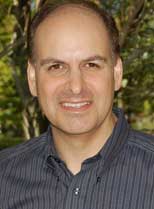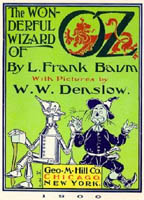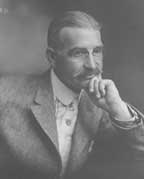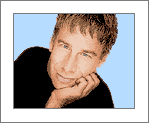Finding Oz - The Wizard of Oz and Wicked
The Making of Oz Stories - Creativity in Oz
By Carol de Giere
 On this website devoted to the work of Wicked's songwriter Stephen Schwartz, I'm including an interview with author Evan Schwartz, another Schwartz who is not related to Stephen but has written a book that is relevant to the material presented here.
On this website devoted to the work of Wicked's songwriter Stephen Schwartz, I'm including an interview with author Evan Schwartz, another Schwartz who is not related to Stephen but has written a book that is relevant to the material presented here.
As I explain in my book Defying Gravity, in 1996 Stephen Schwartz come up with the idea of making a musical he would call "Wicked," adapted from Gregory Maguire's novel Wicked. Maguire's novel was inspired from the story and characters developed by L. Frank Baum in The Wizard of Oz. Evan Schwartz's new book Finding Oz, explores the development of this original tale, The Wizard of Oz.  [Photo to the right: author Evan Schwartz]
[Photo to the right: author Evan Schwartz]
Here is my interview with Evan, the author of Finding Oz: How L. Frank Baum Discovered the Great American Story. Evan I. Schwartz is a former award-winning editor at BusinessWeek and is also the author of The Last Lone Inventor, named one of the 75 best business books of all-time by Fortune magazine. He also wrote Juice: The Creative Fuel That Drives First Class Inventors. He lives with his family in Connecticut. The idea for Finding Oz came to him while reading Baum's classic out loud to his daughter at bedtime.
Carol de Giere: I'm curious if you remember the first moment when you thought of doing this.
 Evan Schwartz: Yes. It was about three and half years ago. I was reading Baum's original novel out loud at bedtime to my daughter, Lily, who was in second grade. And we have this tradition where we read books at bedtime and I noticed that I had several copies of The Wizard of Oz around the house and hadn't read it in a long, long time. So we decided to go for it and I was inspired by her reaction to it.
Evan Schwartz: Yes. It was about three and half years ago. I was reading Baum's original novel out loud at bedtime to my daughter, Lily, who was in second grade. And we have this tradition where we read books at bedtime and I noticed that I had several copies of The Wizard of Oz around the house and hadn't read it in a long, long time. So we decided to go for it and I was inspired by her reaction to it.
But also, at the end, we turned to the little bio paragraph of Frank Baum and it said that he failed at all these careers and then in his early 40s, (which is my age as well), he suddenly writes The Wizard of Oz. So I thought there's got to be a great story there.
And I've always had in the back of my mind the question: How did one man invent all these icons of the imagination, from the yellow brick road to the Emerald City. But it was at that moment that I decided to start researching it, and that sent me on a road of research that took me to all these different places where he lived.
CD: At some point you decided that you wanted to add to the existing literature, so you must have discovered the dozens of Wizard of Oz and L. Frank Baum books. What did you think your book would do differently?
 [Photo: L. Frank Baum in 1911]
[Photo: L. Frank Baum in 1911]
ES: I didn't want to write a complete biography because I wanted to focus on what was most interesting to me, which is his journey leading up to when he created his masterwork. There are some books that analyze The Wizard of Oz from a literary point of view and there are a couple of complete biographies that I think miss the heart of the story, which is Baum's own spiritual journey and transformation. What I wanted to add was I wanted to discover new things about him in those 18 or 20 years leading up to the book. And I also wanted to really flesh out the context of what was going on around him and decode the meaning and true origins of the story.
CD: Would you say you were looking for the genesis of the icons in a similar way to what Wicked does in the musical and novel.
ES: Yes. Wicked is a fictional backstory of what happened before The Wizard of Oz and mine is the true story of how people, places, and events in Frank Baum's life inspired the creation of everything from the Scarecrow, Tin man, and Lion to the Emerald City.
CD: You're saying it is the "true story." Did you find writing of Baum's that confirms any of it or did you set it up to see what it might be?
ES: I found writings of Baum's that confirmed aspects of it. For instance, he very much embraced Theosophy... If you look at that literature, and Baum writes about some of it, especially in his newspaper articles, it talks about how this transportation was created.
Dorothy goes to Oz in a tornado but there's been this controversy of—is it a dream or is she physically going there or something else? It really is something else. It's about that visionary mind—that transcendental mind that is described by Hinduism and Buddhism and also the American Transcendentalists like Emerson and Thoreau. They talk about this experience that is sometimes called Satori or Samadhi and Baum not only studied this but he experienced it.
CD: I always think of Theosophy as a philosophy.
ES: It's really a study of all religions and it is an exploration of this mystical realm and in supernatural occurrences and the power of the mind to imagine a better world.
CD: Do you think there were other aspects of his character that contributed to his ability to imagine? His mother-in-law characterized him as a dreamer. He was imaginative, wouldn't you say?
ES: He was always a great storyteller. He wanted to grow up to be a great writer and novelist. He had to give up that dream to support his family with a variety of careers: selling oil, a chicken breeder, running a store, editing a newspaper, but he was essentially on this zigzag journey back to his true self.
Most people never get to experience that—to go back to their childhood dream. And his mother-in-law did recognize that. When he told stories to kids he was the happiest. And she told him to write them down. And she of course is an incredible inspiration for the characters in the book, too.
CD: The Wicked Witch of the West?
ES: Matilda Joslyn Gage, the mother-in-law, was against the marriage at first. She didn't want her daughter, Maud, to drop out of Cornell. Maud was one of the few female college students in America who was going to Cornell, so she was against this. Matilda gave Frank a hard time because he was a traveling actor and didn't have a steady job, but she studied the history of Medieval witch hunts and was one of the leaders of the women's rights movement (although she was radical and controversial and essential written out of history and kicked out of the movement for her views). She not only inspired the mythical Wicked Witches of Oz but also the Good Witch.
In the relationship between her and Frank, she transforms from an antagonist to a mentor. The genius of The Wizard of Oz is that it has a dual view of witches: They can be good and bad, they can be beautiful and ugly and it really all depends on your own vision of what a witch is. A witch is really a metaphor for your fears or your hopes.
CD: Who do you think will find your book most interesting?
ES: Oz fans, for sure, but I think the core readers will be people who love American history, because Frank Baum's life and history of the times were so intertwined. He crossed paths with a lot of famous people from Thomas Edison to PT Barnum. And he also was intertwined with a lot of the things going on like the women's movement with his mother-in-law, the economic calamities that were going on (which have a lot of parallels to today—there was a credit crisis in 1893 that was spookily like ours) and the history of the World's Fair of 1893 in Chicago (which inspired the Emerald City) and the whole move Westward. The mythology of the American West and manifest destiny is a big part of this story because he left the East, Syracuse, to find his fortune out West. He moved to South Dakota. He didn't quite find his fortune but he found a great story.
CD: You've talked about the philosophical underpinnings of The Wizard of Oz. What about his internal personal conflict? Sometimes writers gravitate to a story because they are working out something internally or they are especially fired up about a particular issue they are going through. Was that true for Frank Baum?
 ES: I think there were some inner demons going on in his own psychological development. He had a defective heart because he had this childhood disease. I think he was very much aware of that. And the fact that he was involved in the oil business, selling cans of lubricant, those two things combined in a lot of ways to inspire the Tin Man.
ES: I think there were some inner demons going on in his own psychological development. He had a defective heart because he had this childhood disease. I think he was very much aware of that. And the fact that he was involved in the oil business, selling cans of lubricant, those two things combined in a lot of ways to inspire the Tin Man.
And I think he had a really dark episode from his childhood where he was sent away to a military academy and he was punished there for being a dreamer. He didn't really fit in and he had a heart attack at age 14 or he faked one really well and he got sent home. That may have instilled in him a feeling that he was a coward. All his classmates went on to fight wars. They are in the army and the military fighting against the Indians. So I think there was that inner demon that came back later…..
Creating the Land of Oz was a way of creating sort of a lost, idealized America where everyone has a place.
CD: If the O-Z file cabinet story is false, how do you think he came up with Oz? [The story that he selected the name Oz based on the file cabinet drawer label that used the letters O – Z.]
ES: The O-Z file cabinet story has become part of the legend. I believe it's almost certainly false because he came up with the explanation several years after writing The Wizard of Oz as a way to explain it.
Where did the name Oz come from? I'm not exactly sure. There are several theories. It could be from the Bible, as Oz is the Hebrew word for strength. It could have to do with the shape of the letters: the eternal O [circle] representing the journey of spirituality and the Z, the zig zag path of life coming together. Or it could have been just sort of a fun word that alliterated with Wizard. It's a mystery.
The main thing about the file cabinet story is that it makes it seem random and nonsensical like it was just a whimsical story without any deep meaning. But the story really does have deep meaning for Frank Baum.
CD: You have over 350 pages here. What are some of the chapters about? Like you have a chapter called "A Girl in a Man's World."
ES: He dedicated The Wizard of Oz to his wife Maud. And so in many ways she was an inspiration for the Dorothy character. Not the only one but she had a very rough time when she went to college at Cornell.
CD: So she was the girl in the man's world?
ES: Yeah. She went to Cornell, which was the first co-ed university on the East coast. There were only 30 women there and she was given a hard time, and also made fun of because of who her mother was. She was very much making her way in a man's world. The university back then was very much a boy's club. So that's why the title of the chapter.
In many ways The Wizard of Oz is this fable of feminism because Frank Baum had 4 sons so naturally he would have created a protagonist of the story who is a boy. But he didn't and I think the reason is that the women's rights movement was so powerful in his own family that he created this story that made the Dorothy character assertive and she could do anything a boy could do, but it's not about power. She didn't try to become the King of Oz or the Queen of Oz. All she wanted to do was to go home, so it was just about the principle that a girl can do this too.
CD: Do you think Baum would have liked Wicked the novel or Wicked the musical?
ES: I think he would have been jealous that he didn't write it himself. He kept writing these sequels and the sequels didn't come from the same place. I really believe that the first novel was like a divine inspiration and the other ones were done out of obligation and they were written in haste and a lot of them were nonsensical. He never had the idea of going back and creating a prequel and doing the backstory of his characters, which I think we would loved doing if he thought about it.
CD: What were some of your sources that haven't been used before to create this book?
ES: I found new things. For instance, Frank Baum was a reporter at a small newspaper in Chicago when he first moved there in 1891 called the Chicago Evening Post, and no one has bothered to go through the microfilm to see what he might have written. There's a challenge because there are no bylines. So I was looking for key phrases that were either reflected throughout his writing or that made it into Oz novels or something that was trademark Baumian. And I knew exactly when he worked there. His first day was May 1st, 1891. And on the front page of the newspaper on that very day was an article all about moving, and the philosophy of moving. And there was this phrase in the article, "There's no place like home." And the whole article was threaded with Baumisms. I can't be 100 percent sure that he wrote it but I'm 90 percent sure.
There was another article a week later where the reporter goes to cover a press conference where Thomas Edison is going to talk about his new invention for the World's Fair. And this article uses phrases like "the Wizard has a massive head," and other things that show that Thomas Edison is one of the inspirations for the Wizard character. So finding those new sources was fun.
CD: Some people think that the creative process requires that everything be invented from scratch but so much of what I found in Stephen Schwartz's career is that he and others draw from things that are already there, and spin off of them for something new. Any comment?
ES: I believe hardly anything is invented from scratch. Certainly for The Wizard of Oz he cobbled the story together from common parts: a tin man, a scarecrow, a glimmering city, these were things he saw in America at the time. Even phrases like "There's no place like home" — he didn't create that phrase. All good artists steal; they just hide their sources.
BUY Finding Oz: How L. Frank Baum Discovered the Great American Story.
READ ABOUT THE MAKING OF WICKED IN DEFYING GRAVITY: Defying Gravity
READ ALL ABOUT Gregory Maguire | Visit Evan Schwartz's Finding Oz website FindingOz.com
READ ALL ABOUT Wicked the Musical

